Means of remote mining in the Russian army
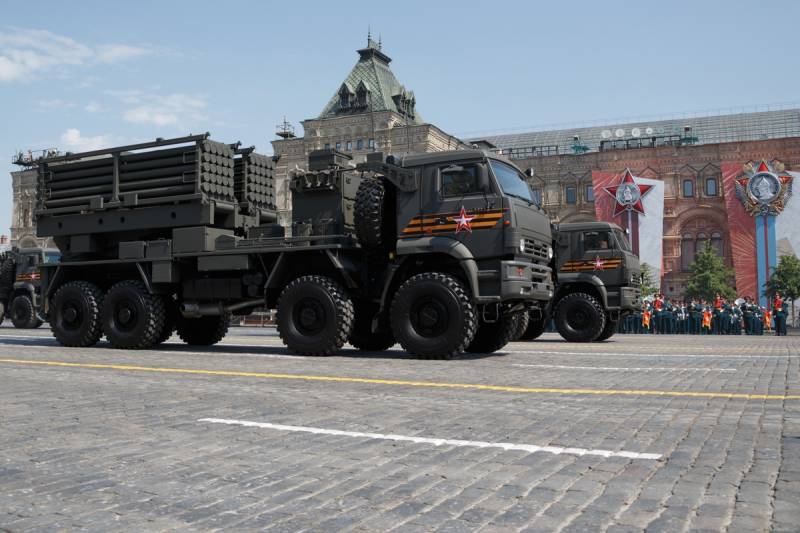
ISDM "Agriculture" at the parade. Photo by the Ministry of Defense of the Russian Federation
In the current special military operation, minefields play an important role. It was mines in different areas that thwarted the enemy’s offensive and inflicted serious losses on him. Various means are used to lay mines, including remote mining systems. The Russian army has several systems of this kind in service, and more are expected in the future.
Combat debut
Last year, for the first time, the latest engineering systems for remote mining (ISDM) "Agriculture" were involved in solving real combat missions. Now such equipment regularly carries out mining in different sectors of the front in order to prevent the enemy from maneuvering. According to various sources, it was the ISDM "Agriculture" that organized minefields in the Zaporozhye direction and made a significant contribution to disrupting the enemy's offensive.
The "Agriculture" product is a kind of multiple launch rocket system on a car chassis, using its own set of ammunition. The combat vehicle carries two transport and launch containers with 25 tubular guides of 122 mm caliber on each. Reloading after a volley occurs by replacing the entire pack.
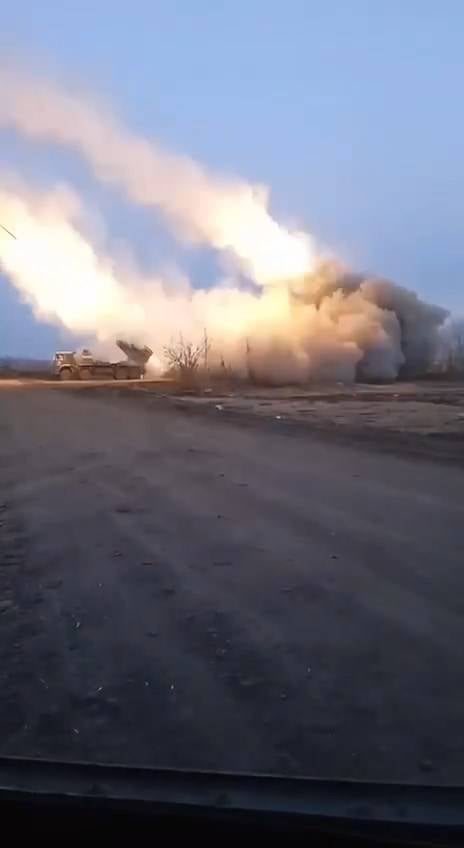
"Agriculture" at the front, 2022. Photo by Telegram / "Parliament with a button"
There is a fire control system with advanced navigation aids and remote guidance control. The SLA also includes devices for programming mines and tools for mapping mining - the latter are immediately transferred to the unit commander or to a higher headquarters.
The exact nomenclature of 122-mm missiles for the ISDM "Agriculture" and their payload have not yet been disclosed. It is known that the firing range of such projectiles reaches 15 km. The ammunition is carried by anti-tank and anti-personnel mines of unknown types. Declared the possibility of programming self-liquidators. Some mines have remote control - the operator can turn off or turn on products in the whole area.
ISDM "Agriculture" due to the wheeled chassis can quickly arrive in a given area, quickly fire and mine the indicated remote area. Information about this production immediately goes up to be taken into account in further planning and in order to avoid negative consequences. After a quick reload, the ISDM can again enter the position and mine a new area.

The head of the 220-mm projectile 9M27K3. Photo Russianarms.ru
Long range
Previously, as a means of long-range remote mining, it was proposed to use standard multiple launch rocket systems in service with the ground forces. To do this, missiles of several calibers and types should be used, carrying a cassette with mines of different models.
In the past, two types of mining shells were produced for the Grad MLRS. The 3M16 product carried five POM-2 anti-personnel ammunition, and three PTM-9 anti-tank munitions were placed in the 28M3K missile. Similar ammunition in caliber 122 mm was developed abroad. The launch range of such products reaches 13-13,4 km.
The arsenals contain 220-mm rockets with mines for the Uragan MLRS. Thus, the 9K27M2 and 9M59 products are designed to organize anti-tank minefields with PTM-1 (24 pieces) and PTM-3 (9 pieces) ammunition, respectively. Anti-personnel barriers are created using 9M27K3 missiles with PFM-1S mines - 320 each. Mining is carried out at ranges up to 30-35 km.

Product 9M55K3 in section. Missilery.info graphics
The Smerch / Tornado-S system also has the ability to install mines. For this, 300-mm rockets 9M55K3 and 9M55K4 are used. The product of the K3 version carries 64 POM-2 anti-personnel mines. In "K4" placed 25 anti-tank PTM-3. The maximum firing range is standard 70 km.
Universal systems
The engineering troops are armed with universal minelayers UMP. These are remote mining systems for unified ammunition, with the help of which barriers for various purposes can be created.
In the original version, the UMP is a truck equipped with six launchers and fire controls. In the war zone, there are now other versions made in artisanal conditions. So, on an existing platform with a lower carrying capacity, they can install not a complete set, but only one or two launch blocks.
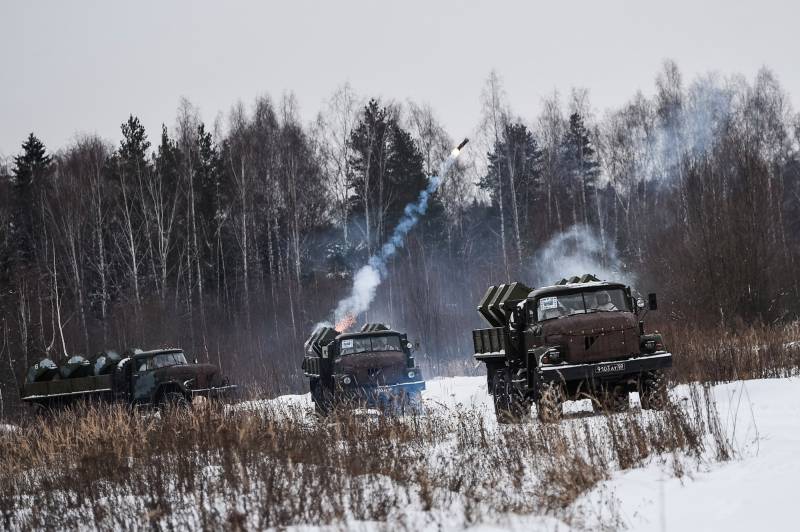
UZM barriers at work. Photo Russianarms.ru
The starting block is a hexagonal product with 30 cells for universal cassettes. The block can be induced in two planes, due to which the range of the release of mines and their dispersion is determined. At the same time, the range of the mine, depending on its type and mass, does not exceed several tens of meters.
UMP uses universal cassettes in the form of a glass, containing a propellant charge and mines of various types. In this form, the PFM-1S, POM-1, POM-2, PTM-1 and PTM-3 mines were supplied to the troops. With the help of an electrical control system and propellant charges, mines are fired in the direction of a given area. UMP can simultaneously lay mines of one or more types; installation from one to three lanes is provided.
Promising family
A direct continuation of the ideas and concepts of the universal UMP is the Kleshch family of minelayers. It was developed several years ago, and at the same time three unified minelayers were shown at once. They use common target equipment, but are made on different bases.
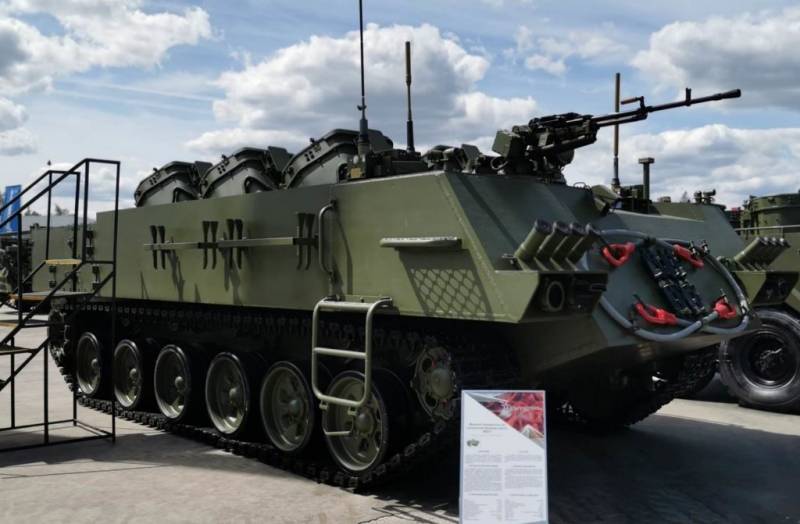
Promising minelayer UMZ-G "Kleshch". Photo by NPK "UVZ"
The Kleshch family is unified in launch blocks and cassettes with mines. Again, polygonal blocks with 30 cells are used, capable of receiving cassettes of different types: new options for their filling have been developed and compatibility with the old ones has been maintained. The main features and parameters of launch vehicles as a whole have not changed.
The largest and heaviest in its family is the Kleshch minelayer of the UMZ-G version, built on the basis of tank T-72. This machine is equipped with an open top cabin, inside which there are 9 blocks for 270 cassettes. Six blocks are carried by the Kleshch-K vehicle, the base for which was the Asteys-70202-0000310 armored car. The lighter Typhoon-VDV became the basis for the Kleshch-T minelayer. It managed to place only two launch blocks.
It is assumed that the Kleshch products will help the engineering troops retain all the characteristic capabilities of the UMP minelayers, as well as improve them with new cassettes with modern mines. At the same time, the presence of several versions on different chassis will positively affect mobility and other aspects of combat use. However, as far as is known, while the "Ticks" are being tested and have not yet entered service.
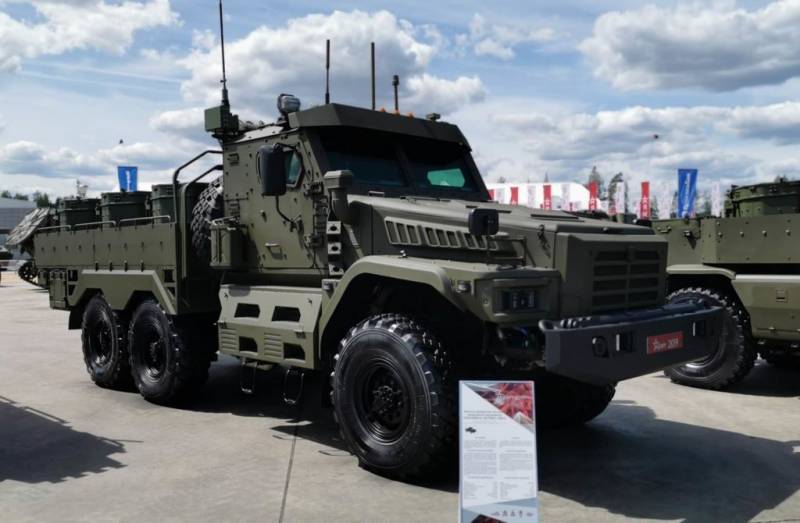
The average representative of the Kleshch family is UMZ-K. Photo by NPK "UVZ"
Mines and mining equipment
Despite the apparent simplicity and the existence of various means of neutralization, mines of different classes and types remain effective. weaponscapable of influencing the course of battles. Equally important are the means of their installation, primarily remote. The Russian army has several systems and means of this kind in service, and measures are being taken to further develop the fleet of such equipment.
It is easy to see that due to the products of UMP, "Agriculture", 9K27M2 / 3, etc. in the engineering and ground forces, a developed complex of mining equipment with broad capabilities is being created. The army gets the opportunity to install obstacles for various purposes with certain mines in areas in a wide range of ranges.
Due to the quick and high-quality mining of different areas, you can seriously influence the enemy. Depending on various factors and circumstances, minefields will stop him or force him to take additional measures. What all this can lead to is shown by recent events in different sectors of the front. Thanks to our mines, Ukrainian formations have already lost a large amount of equipment and manpower.
Information